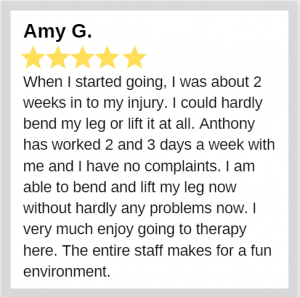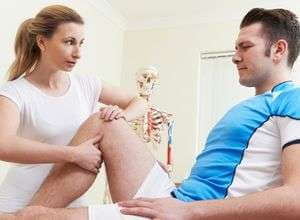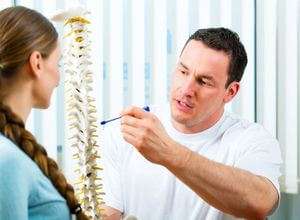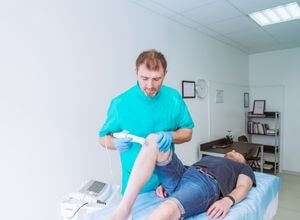If you suddenly got a sports-related injury, going to a sports therapy doctor is better than going to your family physician. Sports medicine is mainly about n treating and preventing exercise- and sports-related injuries, so a sports therapy doctor is better equipped to help you.
Aside from diagnosing and treating these injuries quickly, a major benefit of sports medicine doctors is that they know the right way to implement alternative methods to avoid requiring surgery. Whereas many physicians may quickly recommend surgery, a sports therapy doctor would try other methods first.
Who Are Sports Therapy Doctors?
When thinking of a sports therapy doctor, you probably picture a physician waiting on the sidelines and jumping into action whenever an athlete is injured during a match. They are specially trained to quickly diagnose and treat injuries sustained from playing sports and other orthopedic (musculoskeletal) injuries. They aim to get the player back to their sport as safely and quickly as possible.

They also strive to help people exercise safely and effectively to achieve optimum performance. That includes prescribing strength training for muscles that the physician notices lack balance with other muscles.
Injuries Treated By A Sports Therapy Doctor
Here are three of the medical injuries and conditions that a sports therapy doctor most frequently diagnoses and treats:
Rotator Cuff Tear
A rotator cuff tear is a kind of injury that affects the group of tendons and muscles that support a person’s shoulder joint. It frequently affects those who repeatedly conduct overhead motions, such as tennis players and baseball pitchers; it can also affect those who conduct incorrect repetitive motions that pull on your shoulder. The tear could be partial or total, and a total rotator cuff tear might require surgery.
Symptoms usually begin with a dull ache in the shoulder. It usually causes sleep disturbances, especially lying on the affected shoulder. Patients with this shoulder injury usually complain of arm weakness which makes it difficult to comb their hair or wear a shirt.
Achilles Tendon Rupture

The Achilles tendon might tear or rupture when extreme pressure is placed on the back of your lower leg or even with foot impact, like landing from a jump. Patients with a torn Achilles tendon might feel a sudden onset of sharp pain in the heel area. Others might also hear a snapping sound as the tendon breaks, making walking very difficult.
Ankle Sprain
An ankle sprain is an injury in the ligament that surrounds and connects the ankle’s bones. An ankle sprain usually occurs when you twist your ankle severely and awkwardly, resulting in a tear or stretch of the ligaments that hold your ankle bones together.
Treating Medical Conditions
A sports therapy doctor could also handle chronic or acute illnesses and nutrition and performance issues. Additionally, they can help patients determine when to return to their day-to-day activities after treatment.
Their work includes primarily of injury management to guarantee fast recovery and a safe return to the sport, such as the following:
- Facilitating and monitoring injury prevention
- Diagnosing an injury accurately depending on pathology and location
- Identifying the main cause of an injury to avoid a recurrence
- Prescribing rehabilitation and prescriptions as needed to help heal and restore functionality
- Minimizing time away from the sport
- Maximizing long-term performance
Sports therapy doctors could work closely with other medical practitioners, such as orthopedic surgeons, therapists, and dieticians.

It’s a common misconception that a sports therapy doctor only treats athletes. These physicians would attend to anyone who wants to improve their overall health and wellness. Plus, because they are specialists in orthopedic medicine, they are excellent at treating joint issues such as arthritis and sudden injuries such as a twisted knee or a sprained ankle.
Benefits Of Going To A Sports Therapy Doctor
Sports doctors are not just for top athletes. There are numerous reasons to see a sports therapy doctor. These doctors have specialized training to tend to injuries that result from any exertion. They are specialized in musculoskeletal problems and finding ways to prevent, treat and manage them.
These doctors can benefit all active people who may have suffered one-off injuries, like in a car accident or a work environment.
Their main purpose is to restore body movement in the injured area with less pain. Here are four major benefits of seeing a sports therapy doctor:
1. Sport Injuries
Sports doctors could treat injuries using both surgical and non-surgical methods. That may require surgery and physical therapy if you’ve torn your ACL. A sports therapy doctor could help you with or manage the entire process, referring you to experts as needed.

In some cases, injuries might require non-surgical measures. In these situations, the sports therapy doctor would recommend certain exercise regimens, perform joint mobilization techniques and potentially conduct minimally invasive injection therapy on the joint.
2. Injury and Pain Treatment
Injuries often come with chronic pain that could last weeks or months after the fact. Sports doctors specialize in pain management which does not require surgery. These treatments wind up being highly personalized. The sports therapy doctor would find the best blend of treatments for your injury, including steroid injections, joint injections, trigger point injections, or supplements, to name a few.
3. Rehabilitation
After receiving treatment, you often need rehabilitation to build your muscle and strength. A sports therapy doctor develops a customized rehabilitation program to guarantee fast, effective recovery. They aim to help you build that flexibility and strength much faster, so you can get back into the game sooner.
4. Performance Enhancement
A sports therapy doctor isn’t only involved after injuries but also beforehand. They help individuals reach their maximum potential in exercise and sports. That is done using performance enhancement training and best practice advice on preventing injuries.
Many people who exercise regularly might partake in programs to strengthen the right muscles to minimize potential injury and muscle imbalances. By avoiding injuries, you’re more likely to play the sports you love for a longer time.
Sports Medicine vs. Physical Therapy
What is a sports therapy doctor, and how is one different from a physical therapist?
Sports Medicine
Sports medicine’s goal is to treat and prevent injuries within the context of sports. A sports therapy doctor understands each sport’s movements and physical demands. For example, if you play volleyball, a sports medicine doctor will better understand the cause of your injury than another doctor because they know the required physical motions of volleyball.

When it comes to treatment, a sports therapy doctor will recommend the treatment best for recovering and returning to the same motions as before in volleyball (or soccer, football, etc.) Additionally, a sports medicine specialist will work with you and teach you the proper body mechanics to use in your sport to prevent further injury.
Physical Therapy
Physical therapists work with anyone – regardless of age or sports involvement – to aid in recovering from an injury. Sports medicine specialists often send their patients to a physical therapist – and vice versa. Aside from the sports focus, the key difference between the two fields is that a sports medicine specialist provides a variety of treatments, including surgery. On the other hand, physical therapy uses only stretching and strengthening exercises and tools to help foster orthopedic recovery.

